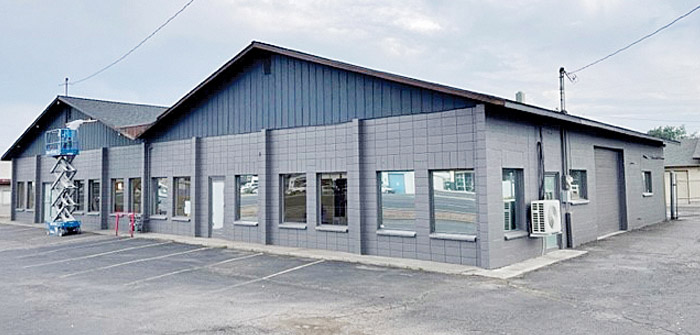(Scott Jewell’s recently remodeled North Redmond Childcare Facility | Photo courtesy Scott Jewell)
We know the story of the small snowball at the top of the hill that begins to roll, gathers momentum and size crushing all in its path.
This short but dramatic illustration represents the US economy when after the Great Recession in 2008 interest rates were reduced and held artificially low. This overheated the economy. Monetary intervention for primarily political reasons created a gigantic cash “snowball” when it was injected with even more government monies during the pandemic.
Too much easy money, consumer spending, and the resultant runaway inflation resulted in the Federal Reserve’s intervention through rapid escalation of the Fed Lending Rate.
Local commercial real estate transactions are one of the casualties in the path of this “economic snowball” and it has dramatically impacted investors, owner/users and tenants. Three years ago, commercial property was sold and leased as fast as it hit the market. Those transactions now look dramatically different as interest rates “snowballed” their profitability.
Impact on Investors
As the Fed hiked interest rates, riskier investments, particularly those financed with variable loans that increase with the interest rate, became unappealing.
“The U.S. economy’s strength and continued tight labor markets could require still tougher borrowing conditions to control inflation,” Fed Chair Jerome Powell said recently. Already a wave of corporate bankruptcies are washing through the economy.
Scott Jewell has investment properties in Central Oregon. He says, “With the current interest rate we have now after the 11th rate hike, investors are nervous and proceed cautiously. Higher rates translate into higher lease rates. Generally, this is not the right time to be buying investment property. I can get 5.25% in a CD with no risk.”
Commercial real estate loans for the purpose of buying investment property have a shorter term than those for residential. Unlike residential loans, the terms of commercial loans typically range from five years (or less) to 20 years, and the amortization period is often longer than the loan term. A lender might make a commercial loan for a term of seven years with an amortization period of 25 years.
Jewell says, “Many loans that were written 2 to 4 years ago have 5-year terms. Those loans will go from 4% to a new refinance rate close to 8%. The payment will increase significantly. This will spell disaster for many investors.”
John Gittelsohn of Bloomberg, says, “About $1.2 trillion of debt on U.S. commercial real estate is ‘potentially troubled’ because it’s highly leveraged and property values are falling. Office values have tumbled 31% from a peak in March 2022.”
Defaults are likely to increase as property values fall and costs rise for landlords who need to refinance at higher interest rates.
Impact on Owner/Users
Owner/Users might be in a better position than pure investors to buy commercial real estate. A Central Oregon banker recently shared that the impact of high interest rates on owner/users is situational. Lenders are still making loans but the borrower can expect much higher payments.
The banker points out however, it might still be a benefit to the owner/investor if the real estate purchase creates a better business environment that overcomes the higher loan interest and favors the bottom line. If the loan makes financial sense, the rate should not stop the borrower from making an otherwise sound decision. He says, “You marry the loan but date the rate.”
He also suggests a short term lease with option to buy that locks in a purchase value now rather than an inflated value in the future. Most regional lenders have strong liquidity with money to loan. Some creative options for structuring a loan include support from Business Oregon and SBA.
Impact on Tenants
Central Oregon commercial brokers report there have been national tenants walking away from properties. The Bank of America’s Redmond branch has this website posting: “Drive up is closed but the lobby is open for clients. This location will permanently close August 6, 2024.”
Office space is particularly hard hit throughout the US and more recently in Central Oregon. Compass Commercial Real Estate Services report in Compass Points, “The Bend office market experienced 12,125 SF of negative absorption in Q3 2023 with an increase in vacancy rate from 4.29% in Q2 2023 to 4.88% in Q3. This is the third consecutive quarter with negative absorption and an increase in vacancy. This inventory, added to the 136,027 SF of vacant office space, results in an availability rate of 8.70%.”
Tenants are experiencing sticker shock for office, industrial and retail space because of the increase in landlord costs. Inflation has seriously increased the costs of building operations. These costs include taxes, maintenance and insurance. These costs are usually charged directly back to the tenant along with a 3% annual rent increase. At the end of the lease term, most leases call for an adjustment in the lease to market rate. Market rates have spiked in the last three years.
Steve Curley, executive director of Redmond Economic Development Inc. works daily with “traded sector” businesses wishing to locate or expand their business in Redmond.
“Everyone is holding their breath when it comes to the current interest rate situation,” says Curley. Businesses are “still in touch” with REDI. He continues: “One company with money to expand is cautious in the current monetary environment. Desire to be in Redmond is still there, but it’s a matter of timing for them to take the next steps.”
The Central Oregon commercial real estate market has been significantly impacted by the snowball of high interest rates impacting investors, owner/users and tenants but there is still hope for a soft landing in 2024.





